“When we can choose between behavior that upsets some people and behavior that upsets no one, why would we choose behavior that upsets some people?”
Emily Triplett Lentz of Help Scout posed this question at MozCon 2019 during her presentation on auditing your blog and website for inclusivity, and it blew me away. In this world that increasingly feels like it’s falling down around our ears, it can be difficult to know where to put your energy in fighting discrimination and oppression. Does it make a bigger impact to march, or donate to nonprofits working on these issues? How do we know what to say and do to make a difference?
Emily presented a simple idea: losing all the words that are discriminatory or ableist to make your company and website more welcoming and inclusive. She outlined an easy process to make this happen thanks to a few handy online tools and some dedicated time.
This idea really engaged me, and I couldn’t get it out of my head. I set out to understand more about what inclusivity looks like, how to audit for inclusivity at Rival IQ, and the amplifying impact seemingly small decisions around language can have on the world around us.
What is inclusivity, and why does it matter?
Inclusivity is all about giving everyone a seat at the table by suspending bias and privilege to make room for all. Simple daily actions can be exclusive to marginalized communities, like holding events on upper stories of buildings without elevators or putting together panels at conferences that comprises only one gender or race.
One of the most common ways we exclude–and by “we” I mean every last one of us–is through unconscious use of language. The English language is chock full of words that are inadvertently discriminatory. A common example you’ll see throughout this post is “crazy”: before we dove into this work, I used this word all the time to express incredulity, or even to swap for a word that was “less appropriate” (like: “that’s f*cked up”). Every time I used that word to mark a situation that didn’t go my way or was messy, I was equating those negative emotions with mental and psychiatric disabilities. That’s definitely not what I was going for, but it’s still hurtful to those who do experience these disabilities every day (1 in 4 adults) regardless of my intentions.
Making a different word choice is a heck of a lot easier than making mental and psychiatric disabilities disappear for a quarter of the population. To Emily’s question at the top of this post: if given the chance, why wouldn’t we choose a word that’s good for everyone in pursuit of inclusivity? Knowing that there’s so much work to be done in the world before we reach parity and inclusion, why wouldn’t we make these small but mighty changes in the way we speak and write?
You might be wondering how this all relates to a SaaS blog and website. It’s one thing to make a personal vocabulary choice, but it also makes good sense (business and otherwise) for companies to be looking at inclusive language. At Rival IQ, we keep an eagle eye on how our hundreds of web pages and blog posts convert readers to start free trials. We want to make sure we have innovative ideas, compelling copy, enticing calls-to-action, and dynamic graphics to make the case for Rival IQ. By inadvertently dropping exclusive language into that mix, we’re turning potential customers (and humans who don’t deserve to be discriminated against) away from what we have to offer.
Of course, the benefits here go beyond our bottom line. Rival IQ’s values are all about flexibility, accessibility, and putting people first, from customers to employees. It’s important to us to bring every aspect of our company in line with these values, and increasing our language standards helps us do that.
There’s another benefit to this process that really speaks to the grammar nerd in me: accuracy. Thinking more about what we say and how we say it means our speech and writing becomes more accurate. When I say, “That’s so lame,” I don’t really mean, “That’s so physically disabled.” What I really mean is “That’s so uncool,” so I should just say that instead.
The final case for why you should think more about inclusive language: it’s easy. Really. Let’s jump into how to make this happen at your company.
How to conduct your own inclusive language audit
Step 1: Gather buy-in from the whole office
There’s no point in doing all this work to ax exclusive language from your website only to hear it constantly around the office, so it was important to decide as a company whether or not this was a priority. From meetings with leadership to an all-staff presentation, there was plenty of time to ask questions and understand more about the project before we decided as a company to take the leap.
Easing into inclusivity also left time for 1:1 conversations where we could ask questions to try to understand why we shouldn’t use words we’ve been using our whole lives. These organic conversations were less intimidating than raising a hand in an all-staff meeting and were really important for getting everyone on board with the audit.
Step 2: Create your (initial) list of words to eradicate
Via a lot of online research, asking smart people who have already begun this work, and anonymously crowdsourcing suggestions from Rivalers, we came up with a list of about 25 words we wanted to commit to avoiding.
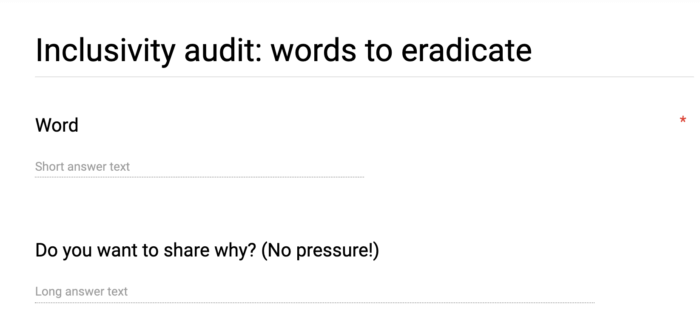
We created a quick Google Form so Rivalers could submit suggestions anonymously.
By sourcing these words from the full company, this went from a Blair project to an everyone project, because we all had some skin in the game.
You can see the full list of exclusive and discriminatory words we’ve committed to avoiding on our blog.
Step 3: Talk it through before you take the plunge
Before I set myself loose on our blog and website, there was one final step: holding a forum so people could ask additional questions and talk through the implications of this project. Another full team conversation was important to have after we created our initial list so people knew exactly what they were committing to.
This conversation was a chance for me to clarify a few of the suggestions that had been submitted that I didn’t understand (still learning!). We also talked through the really common words on our list like “guys” and “crazy,” which we all say often around the office and at home. Can we really commit to these, or should we put them off until we get more comfortable avoiding words? (We opted to do our best.)
One of the most important things we covered in this conversation was about consequences for saying or writing the words on our list. How do we create accountability without shame or policing? The last thing we wanted was a swear jar or a designated member of the office charged with going through everyone’s written and verbal speech because we wanted the audit to be about learning instead of failing. We opted instead to try our darndest and to check in a few months down the line to see how things were going. Are we doing a good job? Do we need to look at a different system of accountability so we can do better against our goal of avoiding these words?
Step 4: Use an SEO spider to crawl your site and blog
We used SEO spider Screaming Frog to crawl our blog and website for every time one of these words showed up. We quickly learned the importance of exact match (or, if you’re feeling nerdy, well-written regular expressions): without these precise queries, “blame” and “flame” turned up when all we really wanted was to find instances of “lame” 🤓. After refining our search a few times, we had a spreadsheet with links to about 250 instances of discriminatory language.
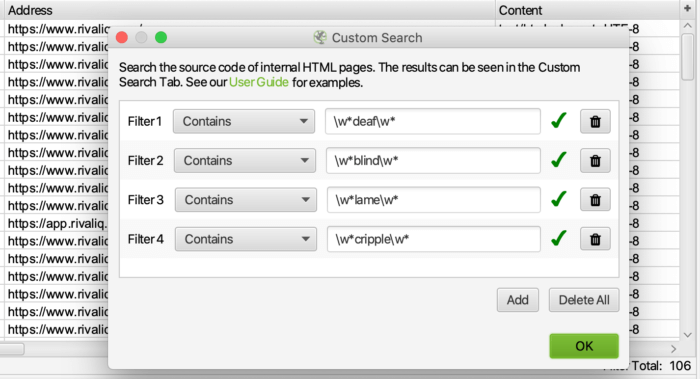
Custom search in Screaming Frog made finding ableist language a snap.
Step 5: Replace all mentions of ableist language
I spent a full day clicking into every link that our crawl found and removing or swapping out ableist language for something more accurate and inclusive. (This project perfectly coincided with a Rival IQ Hack Day, where the whole company stops what they’re doing to work on a work project they really care about.)
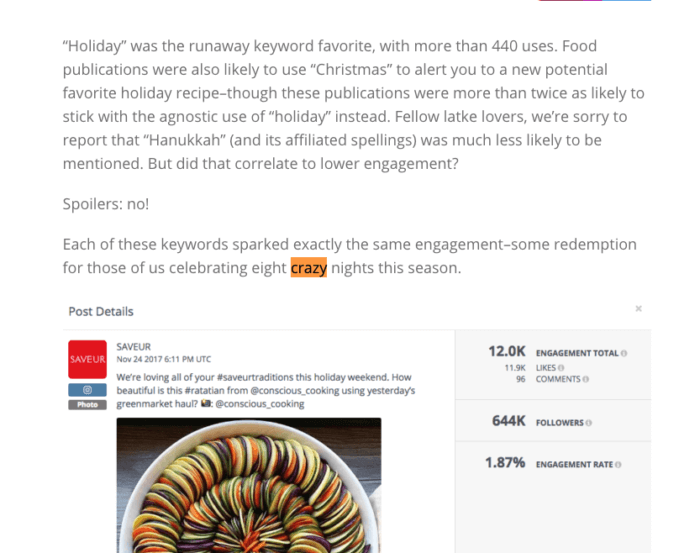
An example of using the “find” command to locate specific instances of exclusive language on our site.
Was it time-consuming? Sure. But it felt great to knock out so many in one day, and in addition to inclusivity, I found a few unexpected upsides along the way.
- There was less rewriting than I thought: In many cases I found, the ableist language was acting as a super-modifier. For example, a “crazy old link” really doesn’t need “crazy” in it to get the point across that something is old. Updating many of these instances was a matter of removing a word instead of needing to do the mental gymnastics to replace it.
- I found lots of other things worth fixing: By spending so much time on so many pages that aren’t touched every day, I found typos, bad URLs, H1s that should’ve been H2s, and other small mistakes.
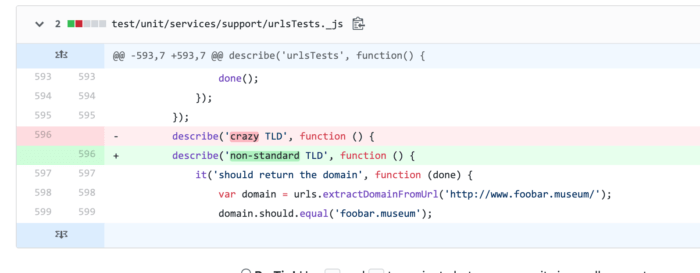
An example of ableist language in our code comments.
I was really focused on our external website, but there are all sorts of internal areas to look through as well. For example, our engineer (and marketing secret weapon) Vijay crawled the code comments in our database and removed all these words as well for even more inclusivity.
Step 6: Publish an inclusive language guide
It can be hard to hear, “Don’t use that word” without knowing what you should be saying instead. To try to remove the barriers, I created a reference document for everyone to use when looking for more inclusive language.
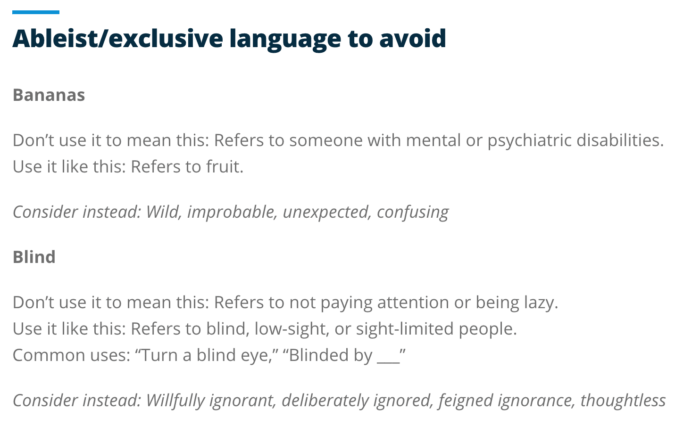
Some sample entries from our inclusive language guide.
I designed the guide to try to make word choices as clear as possible in both absolute and context-dependent cases. For example, we’re really committed as a company to never use the word “crazy,” since it’s unfair and reductive to those with mental or psychiatric disabilities. But as you can see in the screenshot above, we’re not avoiding every use of the word “banana”–just the ones refer to anything other than fruit. When a word or phrase isn’t commonly understood to be discriminatory, like “grandfathered,” there’s a “further reading” link to provide additional context.
Every word in the guide is paired with suggestions for what to use instead to make it as easy as possible to make an inclusive choice.
Step 7: Always be improving
We’ve committed as a company to checking in after a few months to see how this process is going. We’ll cover questions like:
- Are we becoming more aware of what we’re saying?
- Is our language becoming more inclusive?
- Are there additional words or phrases we want to add?
- Are there any words that are too hard to avoid, or that we’re not ready to have on the list after all?
- Do we want to do more to support this initiative?
- What else can we do to make Rival IQ more inclusive?
We were never going to achieve perfection right out of the gate, so checking in regularly will give us a chance to refine and expand the definition of inclusivity at Rival IQ as we all learn more. These regular check-ins also ensure that we preserve the company buy-in established at the beginning of this process, instead of just remaining one person’s pet project.
The impacts of inclusive language
We rolled out the inclusive language guide and cleaned up the Rival IQ website about a month ago. Have we stopped saying every one of these words in the last month? No, but there’s way more awareness now than there used to be.
Coworker after coworker has come bursting into the office with a story about how thoughtlessly these words are used on the radio, in newspapers, on TV, and in books. I’m hearing us all catch ourselves more: using “Hi guys” to start a meeting has now become “Hi team” or “Hey y’all,” and “wild” and “wacky” are becoming natural substitutions for “crazy.” It’s fun to watch our brains rewire so quickly.
I can’t say yet that making these changes will be the thing that takes our start-up to unicorn status, but we hope our blog and website will be a more inclusive and welcoming and less ableist place for digital marketers looking for resources on the web.
Wrapping it up
I’ve simply loved working on inclusivity at Rival IQ, and can’t wait to evolve this guide and process as we continue to learn more. This work is satisfying and important for all writers and marketers to think about, and I hope to see more companies in tech and out working on this soon.
I’m grateful to Emily Triplett Lentz for her comprehensive and thoughtful approach to inclusivity at MozCon and for making herself available to me during this process when I had questions.
Speaking of making ourselves available, please get in touch with us on Twitter with questions about your own audit or suggestions for ways we can continue to work towards inclusivity.
